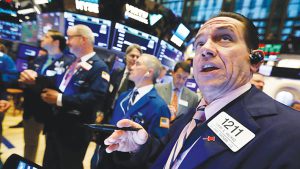BLOOMBERG
Stocks slumped, putting a global benchmark on track for the biggest weekly loss since March, as worries about China and higher global interest rates sapped sentiment. US equity futures were indicated lower, building on the selloff that’s stretched across risk assets. Bitcoin slid as much as 8% and oil was set for its first weekly loss since June. The MSCI World Index was poised to end the week down 2.6%.
Meanwhile, bond markets staged a rebound on speculation losses may be overdone. The yield on 10-year Treasuries fell five basis points, pulling back from levels that were approaching the highest since 2007. UK and German bonds also advanced.
Even with Friday’s retreat in yields, investors are still contending with the risks of entrenched inflation and rates that have moved sharply higher in recent weeks. China’s property crisis and troubles in the shadow banking system have also added to the anxiety in markets and raised questions about possible spillover effects.
The rise in yields “has the ability to dent what has been a very resilient year for risky assets,” said Tim Graf, head of macro strategy for EMEA at State Street Global Markets. “We are in the seasonally weakest time of the year for equities.”
In another sign of nervousness, the Cboe Volatility Index climbed to 18, the highest level since May. Bank of America Corp’s Michael Hartnett warned that stocks may drop another 4%, given China’s economic turmoil and jump in bond yields.
Options expiration is also catching the attention of traders today. There’s some $2.2 trillion of longer-dated contracts tied to stocks and indexes are scheduled to mature on Friday, according to an estimate by Rocky Fishman, founder of derivatives analytical firm Asym 500.
In bond markets, strategists pointed to dip buying as the catalyst for the move. The yield on 10-year UK gilts fell eight basis points to 4.67%. “The underlying story that drove yields higher in the first place is still there,” said ING Groep NV’s Benjamin Schroeder. The global retreat in fixed-income was turbocharged by Wednesday’s publication of minutes from the last Federal Reserve meeting that suggested officials are considering tighter policy.
 The Gulf Time Newspaper One of the finest business newspapers in the UAE brought to you by our professional writers and editors.
The Gulf Time Newspaper One of the finest business newspapers in the UAE brought to you by our professional writers and editors.
